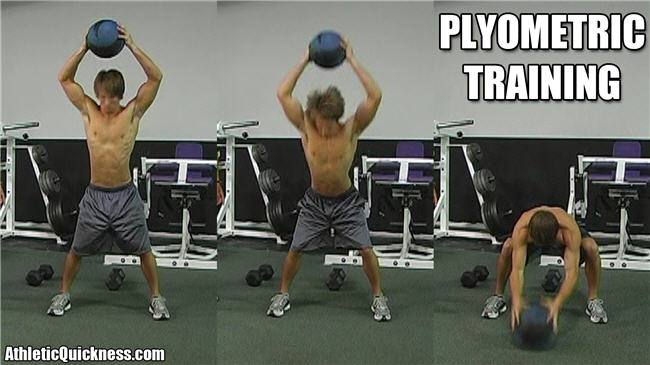The 3 Types of Muscle Contractions Concentric, Eccentric, and Isometric
Your speed training program will deliver your best sports performance when you train your muscles with all three!
Part 3 of 4 – Plyometrics
Part 1 – Muscle Contraction Types
Part 2 – Weight Lifting
Part 3 – Plyometrics
Part 4 – Isometrics
In this section, I am discussing several different types of plyometic exercises and define which types of muscle contractions are involved in the exercise and why that exercise is important to overall athletic performance.
Plyometric Training
Most people use plyometrics training because they involve what is termed “explosive reaction.” Plyometrics is like weight training in reverse, which means the muscles are lengthened first and then shortened. The idea of an explosive reaction comes from the muscles quickly going from a lengthening state to a shortening state.
Plyometrics typically use body weight for resistance. You therefore are more able to simulate sports motions better than with a weight machine or free weights, resulting in all the muscles involved in the sports skill being conditioned during the plyometrics exercise.
Because the exercise is not locked into a specific range of motion, stabilizer muscles are also brought into use to improve balance and coordination. Improved balance and coordination will transfer into greater speed and agility, because the muscles ability to anticipate, react and work together is vastly improved.
What is Plyometric Training?
Plyometric training involves basic movements, such as those ordinarily done during weight training and/or sport specific movements that are typically done outside the weightlifting environment, such as jumping or throwing a ball. The movements are designed to strengthen muscle tissues (much like weight training) and train nerves to stimulate a specific pattern (swinging a baseball bat or golf club, jumping, etc.) of muscle contraction so the muscle generates as strong a contraction as possible in the shortest amount of time.
A plyometric contraction involves first a quick muscle lengthening motion, otherwise known as a voluntary eccentric muscle contraction, followed by a short resting phase, then a rapid muscle shortening movement, otherwise known as a concentric muscle contraction.
One of the main differences between plyometric training and weight training is the order in which the different types of contractions take place. With weight training, you typically have a concentric muscle contraction followed by an eccentric muscle contraction. With plyometric training, it is just the opposite; you have an eccentric muscle contraction followed by a concentric muscle contraction.
Another difference between weight training and plyometric training is the speed in which contractions take place. With weight training, you typically have a slow concentric contraction followed by an equally slow eccentric contraction. With plyometric training, your goal is to attempt to force a very strong eccentric contraction followed immediately by a very strong concentric contraction.
You can turn a weight lifting routine into a plyometric routine if you use less weight and perform the repetitions as fast as possible. But this is typically not recommended due to the high probability of injury.
And, yet another difference is that weight lifting involves weights above and beyond your own body weight in the form of plates, dumbbells, etc., whereas plyometric training typically involves your own body weight and/or lighter weighted objects, such as medicine balls.
This allows your muscles to overpower the resistance they are subjected to enabling them to contract faster (upon request) due to the lowered demand that is placed on them.
Some people believe the action of quickly going from an eccentric contraction to a concentric contraction helps develop a reflex response in the muscles, tendons, and nerves. However, since the concentric contraction immediately following the eccentric contraction is done voluntarily, upon request, the development of the reflex, an involuntary response, is limited.
Examples of Plyometric Exercises
Box Jumps
This is done by first standing in front of a box about the size of 1’ x 1’ and that is capable of supporting at least two times your body weight. Next, squat down with your thighs parallel to the ground and make sure all of your weight is on your toes and not on your heels.
Doing it this way stretches or lengthens three specific muscle groups: the quadriceps (knee flexion), the calf muscles (ankle dorsiflexion) and the hip extensors (gluteus maximus and hamstrings).
This stretching or lengthening of these muscles is the eccentric muscle contraction part of the plyometric exercise. You then want to jump up as fast and hard as you can so that your legs straighten out and you land on top of the box.
As soon as you gain your balance on the top of the box, you need to jump back down, landing on your toes only, and as soon as you land, you’ll need to go straight back down into the squat position where your thighs are parallel to the ground (once again loading/stretching these three muscle groups) and jump again. This process is repeated about ten times before taking a rest.
The most important part of this exercise and all plyometric exercises is knowing that muscles have to be fully stretched first eccentrically before undergoing a rapid contraction concentrically. If this is not done properly, you will not benefit as much as you can from the exercise, nor can you effectively call it a plyometric exercise.
So again, since this is a very popular exercise. Let’s take another look. When you land back down to the ground, you need to make sure you land on your toes first. This will cause the calf muscles to be properly stretched. If you land on your heels first, you remove the calf muscles away from this particular plyometric exercise.
You also need to make sure that after touching back down to the ground on your toes first, you immediately go into a squat position. This will make cause your quadriceps (knee extensor) muscles and hip extensors to be properly stretched. When the calf muscles, hip extensors and quadriceps muscles get stretched, they are undergoing an eccentric muscle contraction. This is the first part of the plyometric exercise.
Now you are ready for the second part of the plyometric exercise. This is when you jump back up again. When you jump up again, your legs straighten out and you land on top of the box. This is the concentric part of this exercise where all three muscle groups contract concentrically. The hip extensors contract, the calf muscles contract and the quadriceps muscles contract.
Medicine Ball Sit-Ups
This is done by sitting on the floor with your knees flexed and your upper body leaning slightly back. A training partner standing a few feet away from you passes a medicine ball to you. You catch the ball allowing the force to push your upper body back and down. You then try to sit up quickly and pass the ball back to the training partner.
The first part of this exercise where you catch the ball and lean back stretches your abdominal and hip flexors. This is the loading component of the plyometric exercise and involves a lengthening of these muscles. Therefore, the abdominals and hip flexors undergo an eccentric contraction.
The second part of this exercise is where you raise back up as fast as you can. This is done by contracting your abdominals and hip flexors. These muscles shorten and therefore undergo a concentric contraction.
This process is repeated, usually ten times in a row, before taking a break. These are incredible exercises to build strength, definition and speed in these muscles. The challenge is overdoing them, and causing injury.
There are many other types and forms of plyometric exercises. For example, running itself is a plyometric exercise, as well as running up stairs. And, various types of agility exercises are forms of plyometric exercises.
Injury is one of the biggest setbacks with plyometrics. Although, they give your muscles a great workout, it is very easy to get carried away with the exercise and injure yourself, especially doing those involving extra weight such as the use of medicine balls. You should at least consult a personal trainer before doing these and others to be safe.
With weight training as the foundation, plyometrics training compliments weight training and develops the athlete and his athletic abilities in ways that weight training is not capable of. Speed, coordination, balance, agility, cardio, skill development, and strength can all benefit from this type of training.
Most of your normal exercises in the gym and in a sports environment along with most of your activities of daily living revolve around muscles that contract concentrically and eccentrically. Normal physical activity, as we know and appreciate, wouldn’t be possible without these types of contractions.
Always glad to help!
Dr. Larry Van Such
Part 1 – Muscle Contraction Types
Part 2 – Weight Lifting
Part 3 – Plyometrics
Part 4 – Isometrics






